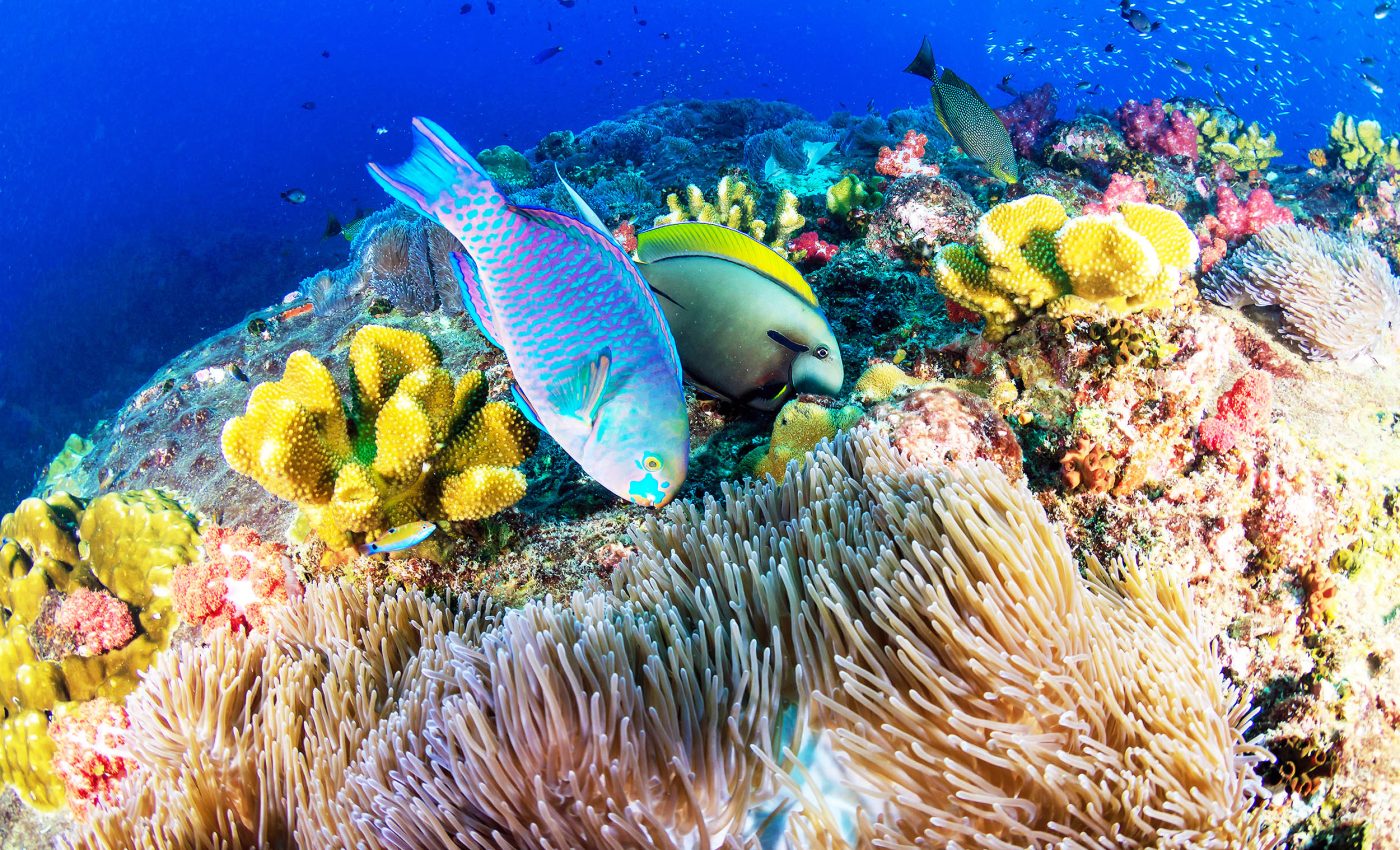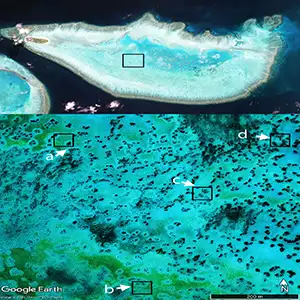
What 'grazing halos' and parrotfish reveal about coral reef health
Coral reefs are among the most dazzling ecosystems on Earth. When viewed from above, they display intricate structures and colors. But many reefs also show curious rings of bare sand encircling them. These circles, called grazing halos, appear in satellite images as pale outlines around patches of coral.
The origin of grazing halos has long puzzled scientists. Why do they form in some places and not others? Why do they vary in size? And most importantly – do they reveal something about the health of the reef?
A new study published in The American Naturalist suggests a surprising answer. It’s not just fear that creates these halos – it’s also the way coral shelter is arranged.
The landscape of fear
One widely accepted theory to explain grazing halos involves fear. Fish like parrotfish and other herbivores leave the safety of coral reefs to feed on algae or seagrass.
However, they do not venture far because predators like sharks lurk in the open. To avoid becoming prey, these fish tend to graze close to shelter.
Their grazing creates visible halos – barren rings where the vegetation has been eaten. The behavior aligns with what ecologists call the “landscape of fear.”
According to this idea, prey animals avoid open areas and concentrate activity near shelter, which alters the way that ecosystems look.
But this explanation has gaps. Some reefs that are full of predators lack halos. Others, where predator populations have collapsed due to overfishing, still show clear halos.
Something else must be shaping these patterns – something embedded in the landscape itself.
Reef shelter layout and halo formation
The new study points to the layout of coral shelters as a missing piece of the puzzle. The researchers examined how the spatial distribution of reef structures influences halo formation. Do halos behave differently when coral is clustered tightly versus scattered widely?
The team used Heron Island on Australia’s Great Barrier Reef to test their ideas. This site is a hub for reef science and faces ongoing threats from climate change, including coral bleaching, storm damage, and ocean acidification.
The study explored how coral shelter layout affects where herbivores graze. Some corals are clustered closely together and provide tightly packed shelter, while others are more dispersed.
The scattered corals create more distance between safe zones. The team predicted that these differences would shape how halos appear – or disappear – across the seascape.
Models predict halo shapes on reefs
To explore this, the researchers built two mathematical models. The first was geometric. It examined how simple circular shapes – representing coral patches – overlap on the seafloor. This helped predict how much vegetation should remain in areas around the patches, depending on how the shelters are arranged.
Study lead author Theresa Ong is an assistant professor of environmental studies at Dartmouth.
“If the shelter habitat is tightly packed in one space, then there’s not much room for nervous prey to explore and less vegetation to eat. But if shelter is more evenly distributed, the halos carve out more empty space in the landscape and their distinctive patterns disappear into one another as they overlap,” noted Professor Ong.
The geometric model revealed that clustered coral leads to clearer, more distinct halos. Scattered coral causes the rings to overlap and blur, making them harder to detect. This may explain why halos vary across reefs – even when predator presence remains constant.
Grazing patterns change over time
Geometry only tells part of the story. Grazing patterns change over time as vegetation regrows and fish populations fluctuate. So, the team developed a second model – one that added time and movement into the equation.
The dynamic model showed two scenarios. When coral patches are dispersed, fish must travel further to feed. This can lead to overgrazing – vegetation disappears, fish numbers drop, vegetation returns, and the cycle begins again. Halos may vanish and reappear in a rhythmic pattern.

When coral is clustered, grazing remains more localized and consistent. This leads to more stable halo patterns.
The models suggest that both stable and cyclic halos can exist on healthy reefs – and both tell stories about how the ecosystem is functioning.
Not all changes are alarming
A major insight from the study is that halo patterns – whether stable or oscillating – are not in themselves signs of reef health or decline. What matters more is how those patterns change over time.
“Oscillating halos are not necessarily a sign of overfishing or poor reef health,” said Ong. “What’s more concerning is if static halos suddenly start cycling or if cyclic halos suddenly become static, which could indicate a major shift in system health and resilience.”
In other words – it’s not the presence or size of the halo that reveals the truth, but whether its behavior shifts in ways that suggest underlying ecological change.
Using satellites for reef surveillance
Studying coral reefs directly is expensive and difficult. That’s where satellite imagery offers a powerful advantage. Researchers can quickly scan large areas and assess general patterns – even from space.
“There are a lot of endemic species on reefs, especially on the Great Barrier Reef, which we could easily lose due to the compounding effects of climate change and overfishing,” noted Professor Ong.
“So gaining a better understanding of how halo patterns reflect reef community dynamics may be useful in reef conservation efforts.”
Halos might become an early warning system. Their changes could alert scientists to shifts in predator numbers, herbivore behavior, or coral shelter integrity – all of which influence reef resilience.
Halo dynamics beyond reefs
The models developed by the team aren’t limited to coral reefs. They apply to any system where grazing happens near shelter.
Think of cattle grazing near trees, or deer feeding near forest edges. The same logic – of safety shaping movement – plays out across many ecosystems.
Still, coral reefs are especially fragile. Climate change is heating the oceans, acidifying waters, and disrupting food webs. Even subtle changes in reef structure can lead to major ecological shifts.
From overlapping rings of sand to predictive models and satellite imagery – this work reveals that coral reefs are writing their own story in patterns we can now begin to understand. We just have to learn how to read the halos.
The study is published in the journal The American Naturalist.
—–
Like what you read? Subscribe to our newsletter for engaging articles, exclusive content, and the latest updates.
Check us out on EarthSnap, a free app brought to you by Eric Ralls and Earth.com.
—–













